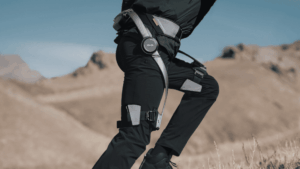Rewriting Your Limits: How the Hypershell X Powered Suit Unlocks New Adventures
Hello, I'm Tak@, a systems integrator. Every day, I'm thrilled by the possibilities technology brings. Imagine if we could break free from our physical limitations and step into places once only dreamed of?
Modern technology has the power to dramatically change our physical capabilities. This means "enhanced suits," once found only in sci-fi stories, are now becoming a reality, within our grasp.
The Evolution of Powered Suits: From Sci-Fi to the Era of Human Augmentation
When you hear "powered suit," many might picture the heavily armored combat robots from sci-fi movies. However, the concept is much broader and is becoming deeply integrated into our daily lives.
The Gap Between Sci-Fi Dreams and Reality
The term "powered suit" traces its origins back to Robert A. Heinlein's sci-fi novel Starship Troopers (1959). In this work, soldiers wore suits providing enhanced offense, defense, and mobility, depicted as "heavily armed and armored" gear. In Japanese sci-fi, Kazutaka Miyatake's designs for Studio Nue, illustrated by Naoyuki Kato, profoundly influenced the concept of powered suits from Starship Troopers, even becoming a root idea for Mobile Suit Gundam. Marvel Comics' Iron Man (1963–) also firmly established the image of a hero with mechanical assistance for an enhanced suit.
However, in the real world, the concept of powered suits first began to take shape more as "assistive devices" than for combat. For example, William Gibson's short story Winter Market depicted an "exoskeleton" for people with disabilities, and John Varley's Blue Champagne featured a similar portrayal. There were also descriptions of it being used to assist able-bodied individuals in moving heavy objects. Contrary to the combat-oriented image portrayed in sci-fi, powered suits in the real world have evolved as tools to alleviate human physical burdens and support capabilities.
The Larger Trend of "Human Augmentation"
I focus on this field because it's part of a larger concept: Human Augmentation. This refers to "technology that freely enhances and expands human capabilities." Specifically, it aims to "supplement," "improve," or "acquire new, previously non-existent abilities" beyond our current physical capacities.
Powered suits, also known as "power assist suits" or "powered exoskeletons," fall within human augmentation, specifically focusing on "locomotor system augmentation." By wearing them almost like everyday clothes, they are expected to augment our muscle strength, reduce the burden of carrying heavy loads, and shorten work times. Their use in medical and nursing care to compensate for abilities lost due to injury or aging, aiding independent living, is also a significant application.
Real-World Evolution and Diverse Applications
Powered suits are no longer just sci-fi tales. Entering the 21st century, their research and development have reached practical stages, appearing in various fields.
Supporting Caregiving and Industry
Japan's declining birthrate and aging population, along with labor shortages, are severe issues in industries like nursing care, construction, manufacturing, and logistics. In these fields, lifting heavy objects or maintaining stooped postures puts a significant physical strain on workers. This is where powered suits demonstrate their true value.
For instance, in nursing care, powered suits like the HAL suit assist the movement of care recipients and reduce the physical burden on caregivers. Hearing that they've already been introduced in over 500 elderly care facilities highlights their widespread adoption. In the construction industry, Obayashi Corporation has introduced exoskeletons that allow workers to effortlessly lift 40kg of material, with over 10,000 exoskeletons reportedly in use nationwide. Manufacturing giants like Toyota have also adopted over 1,500 powered suits in their factories to address labor shortages. Even major logistics company Sagawa Express has incorporated Panasonic's power assist suits, contributing to increased worker productivity.
These examples show that powered suits are not just for "assisting heavy labor"; they are becoming essential for protecting workers' health, extending their careers, and ultimately supporting the larger societal challenge of labor shortages.
Military Applications and Challenges
As depicted in sci-fi, research into powered suits for military use is also extensive. The US, China, and Russia, among others, are actively developing them. Considerations include reducing the burden on soldiers carrying heavy gear over long distances, defense against biological weapons, and stabilizing injured body parts, offering a wide range of capability enhancements.
Projects like the US DARPA's BLEEX and Lockheed Martin's HULC are well-known. HULC boasted impressive performance, capable of running up to 16 kilometers per hour while carrying a 91-kilogram load. However, challenges remain, such as short battery life and the lack of established manufacturing methods for suits tailored to individual body types.
Japan's Ministry of Defense also requested research funding for military powered suits in the past but it was later withdrawn. Military powered suits still face high hurdles to practical implementation, including cost-effectiveness and the necessity of soldier training.
Opening New Frontiers with "AI Integration"
In recent years, the integration of AI has accelerated the evolution of powered suits. With advancements in myoelectric and neuroelectric measurement technologies, they are gaining intelligence to read the wearer's intentions in real-time, providing more natural and appropriate assistance.
For example, at the University of Tsukuba Hospital, AI-powered exoskeleton suits are used in treatment, showing effects in shortening patient recovery times. This indicates that they don't just provide power assistance; they can learn human movement habits and intentions, providing "supportive" assistance tailored to them. It's like the device seamlessly integrates as an extension of our own bodies, feeling natural. I am convinced that this AI-driven "sense of bodily unity" is what truly unlocks the value of powered suits.
Hypershell X — A New Step in Rewriting the Outdoors
And now, at the forefront of this technology, evolving to be accessible to general consumers, is the Hypershell X. With its arrival, I sense a wave of significant change sweeping through the world of outdoor activities, and indeed, our lives.
The Birth of a "Wearable Robot"
The Hypershell X is touted as the "world's first" consumer-grade outdoor exoskeleton (powered suit). Unlike previous industrial powered suits that were heavy and cumbersome, the Hypershell X's biggest feature is its lightweight and high-performance design, built for ease of use by general consumers in outdoor settings.
This device, which fuses robotics and exoskeleton technology, redefines how you move your legs. Until now, many might have felt physical limits on challenging mountain trails or during long treks. The Hypershell X emerges as a new tool to overcome such physical barriers.
Astonishing Performance and Comfort
The specific performance of the Hypershell X is truly remarkable:
- Boosts Leg Strength by Approximately 40%: Dual motors directly apply power to your legs, supporting each step powerfully. It feels like your legs have become much stronger than before.
- Reduces Physical Burden by up to 30%: Significantly less body fatigue during prolonged activities. Previously daunting long-distance treks become more approachable.
- Offsets up to 30kg of Load: An immense benefit for photographers and adventurers carrying heavy camera gear or camping equipment. As someone who develops various AI tools as a hobby and knows the burden of carrying heavy gear, this is truly appealing.
- Battery for Long-Distance Travel: Equipped with a replaceable 5000mAh battery, enabling up to 17.5km of travel on a single charge. It also supports fast charging with a mobile battery, providing peace of mind in outdoor environments where power sources are scarce.
- Intelligent Assist System: The "MotionEngine" AI assist system detects the wearer's movement intentions and posture in real-time from 17 high-precision sensors, providing optimal assist force with an astonishing reaction speed of just 0.03 seconds. Furthermore, it includes a function to learn and customize assistance based on the user's unique walking style (requires app integration).
- "Zero-Gravity" Like Fit: With a lightweight design of just 1.8kg, its ergonomically designed frame is adjustable to various body types. A unique system evenly distributes force across the thigh and calf areas, reportedly achieving comfort that prevents fatigue even during long hours of use. A maximum 300-degree torsional freedom also ensures it doesn't hinder complex movements like mountain climbing.
The Hypershell X comes in three models: "Go X," "Pro X," and "Carbon X," each differing in materials, number of supported motion recognition, and peak torque. For example, the Carbon X uses carbon fiber and 3D-formed titanium alloy, designed for more demanding environments. This signifies that the era has arrived where users can choose a powered suit based on their activity level and purpose, much like athletes selecting gear tailored to their performance needs.
The Future of Human Augmentation and Hypershell X's Implications
The emergence of Hypershell X brings the future of "human augmentation" closer to us. This is not merely about "making things easier" but a significant step that expands our possibilities.
New Experiences Through "Physical Augmentation"
Hypershell X provides both "capability compensation" and "capability enhancement." By reducing fatigue, we can stay active longer (capability compensation), and we can run faster or carry heavier loads than before (capability enhancement).
Addressing the challenges of "cumbersomeness" and "lack of integration with the machine" in traditional powered suits, Hypershell X responds with its lightweight design, ergonomic fit, and natural AI assistance. Being able to use the device without being aware of its presence, feeling as if it's an extension of your own body, is a crucial factor in achieving human augmentation. As this "device integration" improves, its widespread adoption will accelerate further.
Societal Changes and Challenges Brought by Technology
The powered suit market is projected to grow at a Compound Annual Growth Rate (CAGR) of 28.03% between 2025 and 2033, reaching $205.1 million USD. This growth is driven by societal factors like Japan's aging population, a shrinking workforce, and labor shortages in construction and caregiving. The government also supports this field by allocating budget for AI and robotics integration as part of its "Society 5.0" concept.
However, challenges remain. Powered suits are expensive, posing a significant barrier to adoption for small and medium-sized enterprises. In addition to high initial costs, maintenance fees and training costs also arise, causing many companies to hesitate. While government subsidies and leasing programs have begun, widespread adoption may be difficult without further price reductions.
From my perspective as a systems integrator, technology constantly evolves and creates new possibilities. However, for that technology to truly take root in society and enrich our lives, a balance of cost, ease of use, and social acceptance is crucial. Thinking not just about "what technology can do" but "how everyone can use it" will be a key theme for the future of society.
Conclusion: How Far Can Your Potential Expand?
Powered suits, once only seen in sci-fi, are now becoming a reality within our reach. The emergence of consumer-grade exoskeletons like Hypershell X not only affects outdoor enthusiasts but also poses a larger question: how will we confront our physical capabilities and utilize technology?
If powered suits like Hypershell X become more commonplace, how might your daily life and hobbies change? I continue to have great expectations for technology's potential to transcend our physical limits and open up new experiences and avenues for creation. It might just expand our world, like new eyes that allow us to see previously unseen landscapes.



